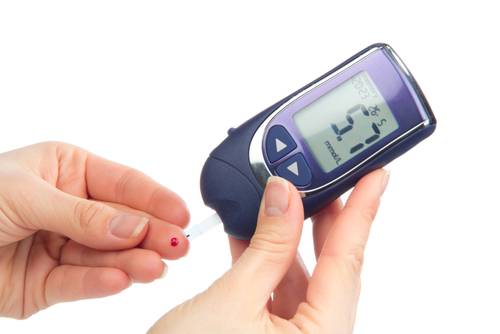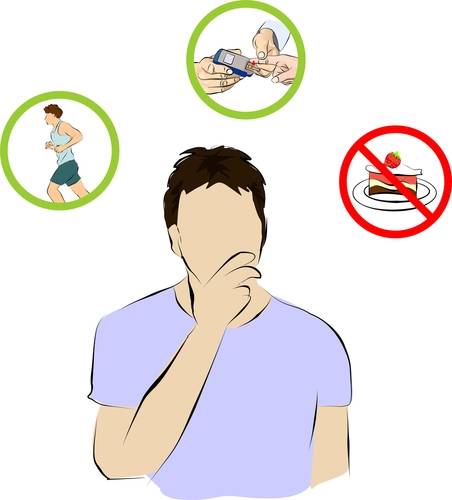As coaches, we will likely have someone with diabetes come through our doors at any given gym. There are different types of diabetes, but we will specifically speak about type 1 diabetes mellitus and type 2 diabetes mellitus. It will be more common for trainers to come in contact with someone with type 2 diabetes than with type 1. Type 1 diabetes is fairly rare, and type 2 diabetes is usually considered “adult onset” diabetes.
Pathophysiology of Type 1 Diabetes Mellitus
Those with type 1 diabetes have an absolute deficiency of insulin cause by marked reduction in insulin-secreting beta cells of the pancreas. Insulin from an outside source must be supplied via injection or an insulin pump. Those with type 1 diabetes are prone to developing ketoacidosis (high levels of ketones) when low insulin levels result in hyperglycemia.
The cause of type 1 diabetes is thought to involve an autoimmune response in genetically susceptible individuals that affects the beta cells that leads to their destruction. The nature of the genetic influence in the pathogenesis of type 1 diabetes is unclear, but the human lymphocyte antigen types DR3 and DR4 are associated with an increased risk for type 1 diabetes.
It’s important to note that this type of diabetes usually appears before the age of thirty, but it can occur at any age. Of the 20.8 million people with diabetes in the United States only 5-10% have type 1 diabetes.
Pathophysiology of Type 2 Diabetes Mellitus
Those with type 2 diabetes are considered to have a relative insulin deficiency, because they can have elevated, reduced, or normal insulin levels. People with type 2 diabetes present with hyperglycemia regardless of their insulin status.
The pathophysiology of type 2 diabetes is still relatively unclear, but contributing factors include genetics, environment, insulin abnormalities, increased glucose production in the liver, increased fat breakdown, and defective hormonal secretions in the intestine. In type 2 diabetes, peripheral tissue insulin resistance and defective insulin secretion are common features. With insulin resistance, glucose does not readily enter the insulin sensitive tissues (think muscle and adipose tissue) and blood glucose rises. When blood glucose rises, the beta cells of the pancreas being to secrete more insulin to try to maintain normal blood glucose concentrations. Unfortunately, this is usually not effective for lowering blood glucose and may further contribute to insulin resistance.
The mechanisms underlying insulin resistance also remain unclear, although they likely involve defects in the binding of insulin to its receptor and postreceptor events, such as glucose transport. Since the majority of people with type 2 diabetes are overweight or obese at the time of onset, obesity is considered a significant contributor to insulin resistance. Most people with type 2 diabetes have lost the first or acute phase of insulin release. Insulin therapy may or may not be required, depending on the degree of functional insulin, or insulin sensitive or responsiveness (or both), remaining. Those with type 2 diabetes do not develop ketoacidosis unless under conditions of unusual stress, such as some sort of trauma.
Of the 20.6 million people diagnosed with diabetes, 90-95% are diagnosed with type 2 diabetes.
Coach’s Corner: Working with Type 1 Diabetes
 Type 1 diabetes care will differ from someone with type 2 diabetes. It’s not that someone with type 1 diabetes can’t exercise, but there are specific things to look out for when working with them and the severity of the disease will differ by person (especially if someone has an insulin pump). Some information from the Canadian Journal of Diabetes is that moderate-intensity aerobic exercise increases the risk of hypoglycemia because of more rapid circulation.
Type 1 diabetes care will differ from someone with type 2 diabetes. It’s not that someone with type 1 diabetes can’t exercise, but there are specific things to look out for when working with them and the severity of the disease will differ by person (especially if someone has an insulin pump). Some information from the Canadian Journal of Diabetes is that moderate-intensity aerobic exercise increases the risk of hypoglycemia because of more rapid circulation.
Exercise enhances the absorption of exogenous insulin, so it’s important that a doctor be involved with any exercise for a type 1 diabetes patient. Since type 1 diabetes patients are on insulin therapy, either by syringe or an insulin pump, adjustments in dosage, careful blood glucose monitoring, and attention to diet at the time of exercise are needed to prevent hypoglycemia. For these reasons, a doctor should be well aware of what types of exercise the patient is doing in case any adjustments need to be made. In some cases, patients on pump therapy may need to decrease bolus doses by 20-50%, and may choose to discontinue basal insulin during exercise.
In regards to brief high-intensity or anaerobic activity, it can cause post-exercise hyperglycemia. For this reason, some patients may decrease their basal insulin by 25% after exercise. Now, I can’t stress this enough: you should not make these adjustments unless you are the physician to the afflicted individual. You must keep in contact with the patient’s physician for them to make these insulin changes. These numbers are simply here to give the exercise professional an idea of insulin fluctuations.
According to the Canadian Journal of Diabetes, small amounts of anaerobic activity in the form of sprints or basic resistance exercises during aerobic exercise sessions may decrease the drop in blood glucose levels associated with moderate-intensity aerobic exercise. But it’s important to mention these theories are still being tested, so as a trainer, always err on the side of caution.
Practical exercise programs should be given for those with type 1 diabetes, but there are a lot of risks in working with those with type 1 diabetes and the priority should always be keeping them safe. It’s best for exercise professionals to work alongside the patient’s physician so you do not cause any extraneous stress or ketoacidosis (which can be potentially fatal). There are many professionals who work with patients with well-controlled type 1 diabetes who wish to exercise for a better quality of life.
Exercise and Type 2 Diabetes
 It’s important for exercise professionals to understand that diet and exercise go hand in hand for those with type 2 diabetes. A six-year clinical trial evaluated the effects of diet and exercise lifestyle interventions on the occurrence of type 2 diabetes in individuals with impaired glucose tolerance. In the study, 577 men and women were assigned to one of four groups: control, diet only, exercise only, or both diet and exercise. It was proven that exercise combined with diet decreased the incidence of diabetes after the six-year intervention.
It’s important for exercise professionals to understand that diet and exercise go hand in hand for those with type 2 diabetes. A six-year clinical trial evaluated the effects of diet and exercise lifestyle interventions on the occurrence of type 2 diabetes in individuals with impaired glucose tolerance. In the study, 577 men and women were assigned to one of four groups: control, diet only, exercise only, or both diet and exercise. It was proven that exercise combined with diet decreased the incidence of diabetes after the six-year intervention.
Now, you may be wondering about the effectiveness of resistance training versus aerobic training, in that now we have many forms of exercise, be they CrossFit, endurance, powerlifting, or yoga. The Journal of Sports Medicine did a study on resistance training versus aerobic training. In the study, both aerobic exercises and resistance exercise were recommended treatments for those with type 2 diabetes, but researchers wanted to find the optimum type of exercise for those with the disease.
The study used a randomized control group with people with type 2 diabetes, with an age range of eighteen years or older. The duration of the trial was eight weeks with a predetermined frequency, intensity, and duration of the exercise. The conclusion of the study found that even though there were some physical fitness differences between the aerobic and resistance groups, the differences were of no clinical importance. So there is really no evidence that resistance training greatly differs from aerobic exercise in regards to the impact on cardiovascular risks or safety.
The important part of this study concluded that for type 2 diabetic patients using one or the other training method is less important than doing some form of physical activity. It’s important that whatever exercise program someone with type 2 diabetes chooses, it will be the one that is right for them. For exercise professionals, it’s important for you to understand how to modify movements for type 2 diabetes patients new to exercise and how to make the best nutrition plan for them in order to improve their quality of life.
References:
1. Hornsby Guyton W and Albright, Ann L., “ACSM’s Exercise Management for Persons With Chronic Diseases and Disabilities” (Illinois: Human Kinetics, 2009), Kindle Edition, Chapter 24.
2. Katch, Frank I, Katch Victor L, and McArdle William D., “Exercise Physiology: Energy, Nutrition, and Human Performance“ (Baltimore: Lippincott Williams and Wilkins, 2007), 452-53.
3. Yardley, Jane E, et. al., “Resistance Exercise in Type 1 Diabetes.” Canadian Journal of Diabetes 37 (2013): 420-26, accessed December 18, 2013, doi:10.1016/j.jcjd.2013.07.020.
4. Yang, Z. et al. “Resistance Exercise Versus Aerobic Exercise for Type 2 Diabetes: A Systematic Review and Meta-Analysis.” Journal of Sports Medicine (2013): ePub, accessed December 18, 2013, doi: 10.1007/s40279-013-0128-8.
Photos courtesy of Shutterstock.






